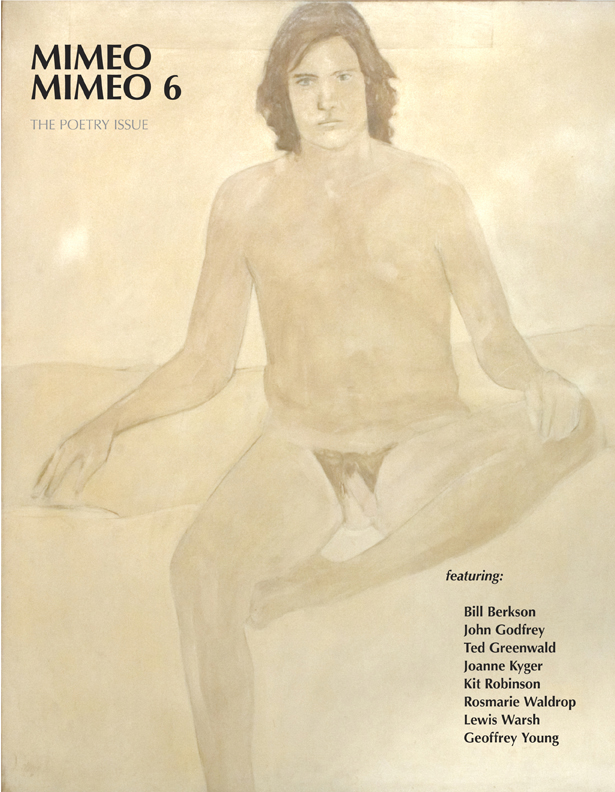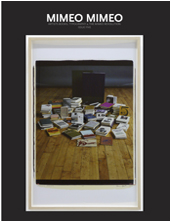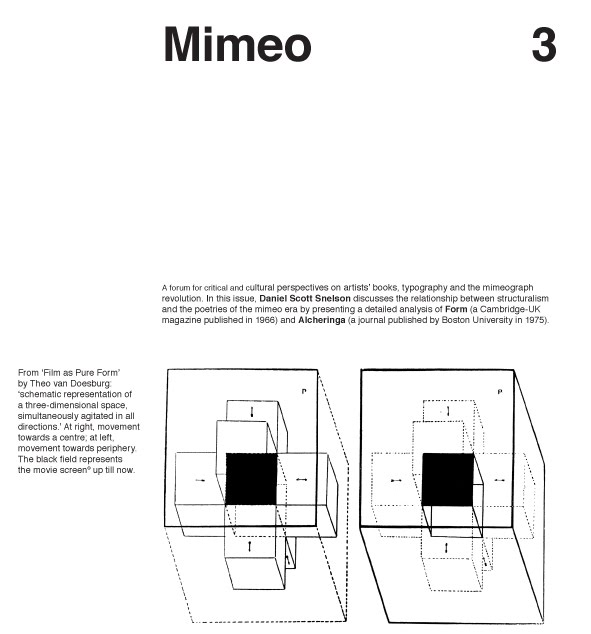INFOLIO & INCOMPREHENSIBLE THINGS
Tom Raworth has a new book out, printed POD DIY, and it's called Incomprehensible Things. Someone on the UK Poetics list asked, "What's Infolio?" Good question, and in case anyone is wondering, here's the link to Tom's very useful and extensive archive of one of the greatest experiments in publishing I know: Infolio.
For Your Reference Library
 Richard Price contributed to Mimeo Mimeo 4 with an article on scanning little magazines. It is embarrassing that it has taken me so long to pick up his indispensible reference, British Poetry Magazines 1914-2000: A History and Bibliography of Little Magazines, co-compiled with David Miller. While at the NY Book Fair at PS 1, I desperately needed a copy to find out if Lee Harwood's Horde, a one-shot little mag from the mid-1960s, was, in fact, a one-shot. Miller and Price told me it was, despite the announcement of a second issue in the closing pages of the first.
Richard Price contributed to Mimeo Mimeo 4 with an article on scanning little magazines. It is embarrassing that it has taken me so long to pick up his indispensible reference, British Poetry Magazines 1914-2000: A History and Bibliography of Little Magazines, co-compiled with David Miller. While at the NY Book Fair at PS 1, I desperately needed a copy to find out if Lee Harwood's Horde, a one-shot little mag from the mid-1960s, was, in fact, a one-shot. Miller and Price told me it was, despite the announcement of a second issue in the closing pages of the first.The back cover blurb reads, "Here is the work of T.S. Eliot, Robert Graves, James Joyce, Laura Riding, Dylan Thomas, Samuel Beckett, Muriel Spark, Harold Pinter, Seamus Heaney, Ted Hughes, Angela Carter, Irvine Welsh and many others." For me, the value of this book lies with the "many others," who were rebelling against many of the names listed above. Not a single British Poetry Revival writer is listed in the blurb above and it is names like Bob Cobbing, Jeff Nuttall, Lee Harwood, Michael Horovitz and Eric Mottram that I search the index for and why I bought the book. It strikes me that the Revival writers took the mantle from the Modernist magazine masters and made great use out of the little magazine, not Seamus Heaney, Muriel Spark, and Ted Hughes. I cannont stress enough that Miller and Price know just how important the Revivial writers were to the British little mag as their chapter accompanying the magazines of 1960-1975 makes very clear. Yet in marketing to the general public and, more important, establishment institutions and libraries, Seamus Heaney, Angela Carter, and Ted Hughes still get all the respect and justify a cash-strapped library to find $95 in its cut-to-the-bone budget. So I should not be that surprised, the Revival Poets still get the short end of the stick. I had to crack a sad smile when Miller and Price's bibliography informs me that the British Library (co-publisher along with Oak Knoll Press) has a complete run of Connolly's Horizon but not of Nuttall's My Own Mag. In fact, the British Library only recently purchased the incredibly important Dutch Schultz issue of My Own Mag for its collection. It seems ironic (yet typical of the state of the academic landscape) that a bibliography on little magazines, that oasis and utopia for the underdog and underappreciated, should promote itself by listing darlings of the establishment.
These are quibbles and my personal axe to grind. The amount of time and effort that went into compiling this absolutely essential reference is staggering. Christopher Harter's mimeo index listed 125 mags, Miller and Price list over 2,000, along with a name index that features well over 5,000 authors and artists. Miller and Price is full of useful information on the Mimeo Revolution (Charles Olson was the anonymous editor of Before Your Very Eyes, published by Goliard) and a must for one's research library.
JB
Miller - Durrell on the Mimeograph
 I just received this email from my friend Charles Talkoff riffing on a reference to the mimeograph in the Miller-Durrell correspondence.
I just received this email from my friend Charles Talkoff riffing on a reference to the mimeograph in the Miller-Durrell correspondence.In the winter of 1936-37 Miller and Durrell were writing to each other with Miller in Paris and Durrell on Corfu. Miller writes to Durrell:
"...I have a little scheme of my own - another! - which I want to propose to you. Perhaps we can do both - adopt my plan and have Laughlin* take it also. I am thinking of investing in a machine, a sort of mimeograph machine which enables one to make innumerable copies from an original typewritten sheet in any colored ink one wants. I have been wondering if, instead of a magazine, with all the difficulties it entails, we could not do better by bringing out one thing at a time, after this process. We could put a thin paper cover around it with the title printed on it - by the same process - or else each one separately, in Chinese ink or something like that.We would send the thing to a select list of people who we think might be interested. Put no price on it, but suggest that they pay what they like towards the expense, if it appeals to them. I haven't solved all the technical problems yet, nor have I the dough..."
This entire piece strikes me as a meta-fiction of the best kind. We are so used to the images and tropes of Miller and Durrell that to look into the correspondence is to read the fiction upon which the reality rested and was filtered to reappear as their respective works of fiction. In other words Miller and Durrell as characters in the ur-narratives of Miller and Durrell who becomes totemic to us - thus the act of reading is a fetish and ritual bringing magic into our consciousness.
To put it still more succinctly of course Miller is in Paris and is hatching a scheme and of course Durrell is in Greece and specifically on an island. Prospero's island and Prospero's Paris identical yet different enough.
We then have the next layer in which (and about which you know more than I do) the mechanics of what one assumes are the first mimeo machines. And all of this prior to the great changes wrought by WWII.
Yet of course in Miller's scheme we see something timeless. The no dough broke-ass writer struggling to find some way to combine distribution and integrity of means and method. Versus of course mass production printing - the ink-drenched nightmare as it were in which the very essence of writing (a thing one does alone) is transmuted and diluted.
Miller's solution is the archetypal underground gesture.
It is the thinking of a monk.
It is the thinking of a romantic.
It is also the thinking of a reactionary and we should not be so afraid that we do not see that aspect in Miller and his monkish romanticism.
In Inside the Whale, Orwell recounts meeting Miller and telling him he was on his way to fight in Spain. Miller tells Orwell he is an idiot.
Orwell of course, the committed socialist; the writer as figure-of-action in the world is (to his credit) torn as he regards Miller as a significant writer commenting upon the slow-moving putrification of the 20th century, and yet...what does one make of Miller's point that the wheel turns endlessly and this war is essentially no different than the other war.
Orwell picks up on this of course and again strikes a somewhat ambivalent tone about the end of Tropic of Cancer where Miller watches the Seine flow as a symbol of eternity.
Quite right says Orwell but (echoing Voltaire?) he comes down on the side of needing to tend to the garden.
And so we have Miller writing to Durrell and both reside with in our imaginations and we carry them with us - some eternal Paris and some eternal Greek island and the romantic monkish gesture of printing endless reams in an endless ocean of multi-colored inks (and foregoing the gross hierarchical notion of debasing art by pricing it before the initiate can respond by telling you what it is worth to them (!)) all combine to tell us something we already knew and are happy to be reminded of.
*Founder of New Directions.
JB
Come and Get It
After a slight delay in printing, we have Mimeo Mimeo 5 in our grubby little mitts. Get one in yours. If you have ordered through the website in the past month, your copy is in the mail. Thanks for your patience and understanding.
JB
JB
ART=TEXT=ART
Thanks to Raphael Rubenstein for the link to the Art=Text=Art exhibit in Richmond: http://www.artequalstext.com/
Shigmurao.org
 Shig Murao: The Enigmatic Soul of City Lights and the San Francisco Beat Scene is officially online: http://shigmurao.org/. As is well known, Shig, who worked at City Lights, sold the copy of Howl that lead to the obscenity trial, and went on trial with Lawrence Ferlinghetti, was written out of the Howl movie. Such treatment reminds me of the 1957 photo of Jack Kerouac that copped Joyce Johnson out of the shot. Johnson took matters into her own hands and wrote the classic memoir Minor Characters. Shigmurao.org has the makings of a classic website that will serve as an archive to all things Shig.
Shig Murao: The Enigmatic Soul of City Lights and the San Francisco Beat Scene is officially online: http://shigmurao.org/. As is well known, Shig, who worked at City Lights, sold the copy of Howl that lead to the obscenity trial, and went on trial with Lawrence Ferlinghetti, was written out of the Howl movie. Such treatment reminds me of the 1957 photo of Jack Kerouac that copped Joyce Johnson out of the shot. Johnson took matters into her own hands and wrote the classic memoir Minor Characters. Shigmurao.org has the makings of a classic website that will serve as an archive to all things Shig.For Mimeo Mimeo readers, the opportunity to view issues of Shig's Review should be a special treat. Unfortunately, Shig's Review has largely been written out of histories of the Mimeo Revolution. Until previewing Shigmurao.org, I had heard of Shig's Review but never actually seen a copy. I was unaware of the publishing history of the Review. I thought the Review ran for many more issues in the 1960s and was shocked to discover just how many issues there were in the 1980s. The site provides a sampler and an index. I know for a fact that this material fills a need for scholars and collectors alike.
JB
6 Decades Books
 I drove up to the NY Book Art Fair last weekend with Brian Cassidy. I was very impressed with 6 Decades Books. A great selection of material that is a bit more representative of the art market than the mags and mimeo that we post here, but the focus on artist's books and the book as an object is right on point. 6 Decades reprinted Germano Celant's Book as Artwork 1960-1972, which I was ashamed to be unaware of. Here is the description of the first edition from the 6 Decades website:
I drove up to the NY Book Art Fair last weekend with Brian Cassidy. I was very impressed with 6 Decades Books. A great selection of material that is a bit more representative of the art market than the mags and mimeo that we post here, but the focus on artist's books and the book as an object is right on point. 6 Decades reprinted Germano Celant's Book as Artwork 1960-1972, which I was ashamed to be unaware of. Here is the description of the first edition from the 6 Decades website: http://www.6decadesbooks.com/2010/10/book-as-artwork-19601972-by-germano.html
Jon Beacham was working the 6 Decades booth this weekend and he recommended the 6 Decades website highly. I spent a little time with it today and it is very good with informative and interesting catalog entries of items I am just not as familiar with as I would like. Hopefully some more time on the 6 Decades website will remedy that.
JB
Subscribe to:
Posts (Atom)




 MIMEO MIMEO #8: CURATORS' CHOICE features 16 bibliophiles on 6 highlights from their personal or institutional collections. Contributors include Steve Clay, Wendy Burk, Tony White, Brian Cassidy, Thurston Moore, J.A. Lee, Michelle Strizever, Adam Davis, Michael Basinski, Joseph Newland, Alastair Johnston, Tate Shaw, Michael Kasper, Steve Woodall, Molly Schwartzberg, Nancy Kuhl, James Maynard, and the Utah posse (Becky Thomas, Marnie Powers-Torrey, Craig Dworkin, Emily Tipps, Luise Poulton, & David Wolske)
MIMEO MIMEO #8: CURATORS' CHOICE features 16 bibliophiles on 6 highlights from their personal or institutional collections. Contributors include Steve Clay, Wendy Burk, Tony White, Brian Cassidy, Thurston Moore, J.A. Lee, Michelle Strizever, Adam Davis, Michael Basinski, Joseph Newland, Alastair Johnston, Tate Shaw, Michael Kasper, Steve Woodall, Molly Schwartzberg, Nancy Kuhl, James Maynard, and the Utah posse (Becky Thomas, Marnie Powers-Torrey, Craig Dworkin, Emily Tipps, Luise Poulton, & David Wolske) MIMEO MIMEO #7: THE LEWIS WARSH ISSUE is the first magazine ever devoted in its entirety to poet, novelist, publisher, teacher, and collage artist Lewis Warsh. Warsh was born in 1944 in the Bronx, co-founded Angel Hair Magazine and Books with Anne Waldman in 1966, and went on to co-found United Artists Magazine and Books with Bernadette Mayer in 1977. He is the author of over thirty books of poetry, fiction and autobiography, the Director of the MFA program in Creative Writing at Long Island University in Brooklyn, and as you’ll soon discover, so much more. Includes an introduction by Daniel Kane, an interview conducted by Steve Clay, 10 new stories, 5 new poems, dozens of photographs and collages, and an anecdotal bibliography.
OUT OF PRINT
MIMEO MIMEO #7: THE LEWIS WARSH ISSUE is the first magazine ever devoted in its entirety to poet, novelist, publisher, teacher, and collage artist Lewis Warsh. Warsh was born in 1944 in the Bronx, co-founded Angel Hair Magazine and Books with Anne Waldman in 1966, and went on to co-found United Artists Magazine and Books with Bernadette Mayer in 1977. He is the author of over thirty books of poetry, fiction and autobiography, the Director of the MFA program in Creative Writing at Long Island University in Brooklyn, and as you’ll soon discover, so much more. Includes an introduction by Daniel Kane, an interview conducted by Steve Clay, 10 new stories, 5 new poems, dozens of photographs and collages, and an anecdotal bibliography.
OUT OF PRINT
 MIMEO MIMEO #6: THE POETRY ISSUE is devoted to new work by eight poets who have consistently composed quality writing that has influenced and inspired generations since the golden era of the mimeo revolution. Contributors include Bill Berkson, John Godfrey, Ted Greenwald, Joanne Kyger, Kit Robinson, Rosmarie Waldrop, Lewis Warsh, and Geoffrey Young. Cover art by George Schneeman.
OUT OF PRINT
MIMEO MIMEO #6: THE POETRY ISSUE is devoted to new work by eight poets who have consistently composed quality writing that has influenced and inspired generations since the golden era of the mimeo revolution. Contributors include Bill Berkson, John Godfrey, Ted Greenwald, Joanne Kyger, Kit Robinson, Rosmarie Waldrop, Lewis Warsh, and Geoffrey Young. Cover art by George Schneeman.
OUT OF PRINT


 MIMEO MIMEO #3: THE DANNY SNELSON ISSUE examines the relationship between structuralism and the poetries of the mimeo era by presenting a detailed analysis of Form (a Cambridge-UK magazine published in 1966) and Alcheringa (a journal published by Boston University in 1975), two exemplary gatherings that illuminate the historical, material and social circumstances under which theory informed art (and vice versa) in the early works of some of today's most celebrated experimental writers. Also includes a special insert, The Infernal Method, written, designed and printed by Aaron Cohick (NewLights Press).
OUT OF PRINT
MIMEO MIMEO #3: THE DANNY SNELSON ISSUE examines the relationship between structuralism and the poetries of the mimeo era by presenting a detailed analysis of Form (a Cambridge-UK magazine published in 1966) and Alcheringa (a journal published by Boston University in 1975), two exemplary gatherings that illuminate the historical, material and social circumstances under which theory informed art (and vice versa) in the early works of some of today's most celebrated experimental writers. Also includes a special insert, The Infernal Method, written, designed and printed by Aaron Cohick (NewLights Press).
OUT OF PRINT
 MIMEO MIMEO #2: features Emily McVarish on her artist's book Flicker; James Maynard on poet Robert Duncan's early experiences as an editor and typesetter; Derek Beaulieu on the relationship between the influential Canadian poetry journal Tish and Black Mountain College; and an extensive interview with Australian poet and typographer Alan Loney conducted by Kyle Schlesinger. Cover is by Emily McVarish.
OUT OF PRINT
MIMEO MIMEO #2: features Emily McVarish on her artist's book Flicker; James Maynard on poet Robert Duncan's early experiences as an editor and typesetter; Derek Beaulieu on the relationship between the influential Canadian poetry journal Tish and Black Mountain College; and an extensive interview with Australian poet and typographer Alan Loney conducted by Kyle Schlesinger. Cover is by Emily McVarish.
OUT OF PRINT

